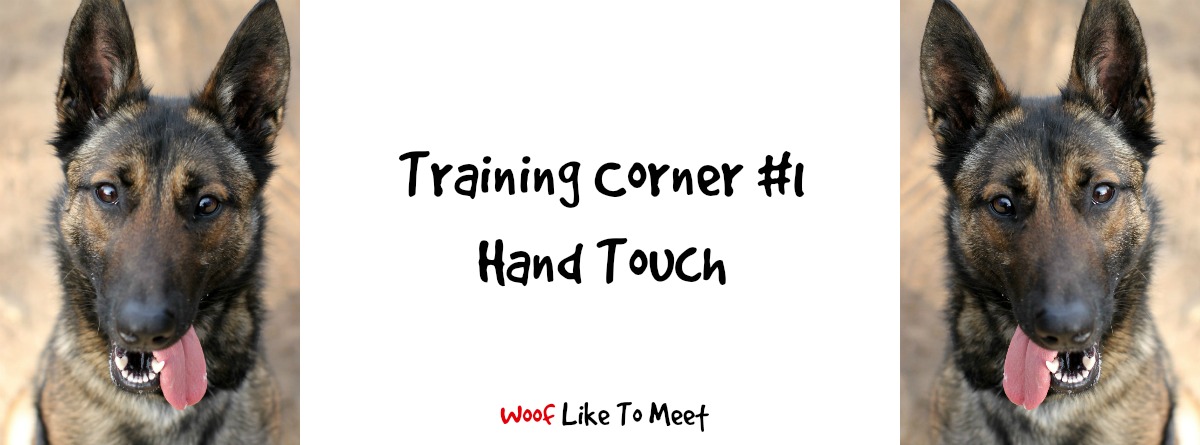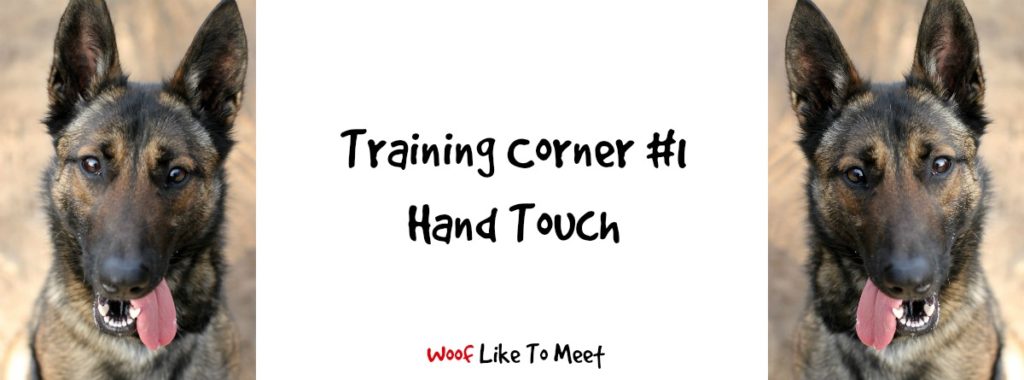Most people never want or need to get past ‘sit/down/stay’, but if you’ve got a smart dog, a teenage dog or a dog who you just want to stretch a little further, I’ve been posting some behaviours you might want to teach on Facebook. Time to do the sensible thing and post them somewhere more permanent!
This week, it’s the hand touch.
Why is hand touch the thing I teach straight after ‘sit’ and ‘down’?
In fact, why might you even use it to teach sit or down?
What are the drawbacks and what other things might it interfere with?
When a dog can come and touch your hand with their nose, you’ve got an instant way to get a recall. It’s also really great because then you can use it to shape other moves, like twist, spin, through the legs, weaves, stand in between your legs, jumps, walking to heel … you name it, if you can move the dog’s nose, the rest of the body will follow. If you have a hand touch, you can even shape a down or a sit more easily.
So it’s great for trick training, agility and obedience.
But it’s also great for husbandry as well. It can start off your dog on a great pathway to standing still for nail clipping, grooming, injections, thermometers – although be mindful with these because if you’ve got a dog with a history, your hand in front of them might be the best thing to bite for redirection or for pain. This is why I prefer a chin touch for those, or a hand touch in a muzzle.
It also gets a dog conscious about touching you with various bits of their body. Dogs don’t generalise well, but once they’ve mastered this, you’ll find it easier to get them moving onto chin touches, foot touches, hip touches and chest touches. If you have a dog who will happily touch your legs with their hind quarters, will press into a hand against their chest and place their chin on another hand, you’ve got a dog who is more secure for vet care or grooming without being restrained. I saw a video of a tiger doing this on Facebook for a voluntary blood draw from its tail. It kind of puts us to shame when a tiger will let you shave its tail and take blood. Yes, there were bars between, but the tiger could have moved away easily. And there we are in the vets restraining our animals or wrestling with them like they’re alligators! A hand touch is a gateway ‘trick’.
Touch is also a great one for dogs who are reactive, for dogs who are chasers, for dogs who are overstimulated. If you have a dog who can touch your hand in all kinds of circumstances, they’re looking at your hand, not at whatever it is that is freaking them out. It is one of the first things I teach dogs who aren’t coping in the world. It can be great to build up to for ‘stranger danger’ dogs, for dogs who have a fear of hands, for dogs who don’t like to approach people. It’s a versatile behaviour for so many, many things in a dog’s life. If you have a dog who is jumping, who needs distracting from chewing, or who is doing something else undesirable, it’s a great interruptor that means you can control where the dog’s head (and therefore the rest of its body) is.
It’s also good for wriggly dogs to get them harnessed up, or to train them to wear a muzzle.
Words of caution:
- Put it on cue. You don’t want your dog bopping your hand all the time with its nose. You are not a treat machine that is operated by your dog’s nose. Make sure your dog is clear about the word ‘touch’ (or whatever word you are using!) When you hear the macho Alpha trainers whining about ‘touch’ as a behaviour, it’s because they think that behaviour is just spilling out of a dog all the time. It won’t if the dog understands there is a sequence. Present hand – say touch – dog touches – mark the behaviour – give reward. Always in that sequence.
- Be mindful that a dog who already knows ‘paw’ can find this hard and will keep giving you their paw. You can work around this by teaching this first or also by putting your hand up higher.
- Make sure you have a distinctive and unusual hand ‘shape’ like a gun or presenting two fingers, or asking for a flat palm. This will also help your dog distinguish between other cues later on which also use a hand.
Some videos for you…
Emily from Kikopup.
If you’re having trouble getting the first movement towards the hand, put something smelly like fish paste on your hand – just enough to smell, not to lick.
Make sure you’ve got contact and that you mark the behaviour at that precise moment. To mark, you can have a clicker, but you can also have a word like ‘yes’.
Make sure also that you practise this in the home, in the street, in the car, on a walk, in the vet’s… everywhere you go with your dog!
In the next video, you can see Nando Brown doing the same. I like his tip about starting with the side of the face, and using ‘Yes’ – only because I’m more of a verbal girl than a clicker girl – simply because most of where I teach is In Real Life, and often that’s out on the street. If you have a lead in your hand, you don’t always have a clicker.
He also starts talking you up to taking pressure. I do love a good firm nose bop.
When you have a good hard nose touch, you can build up the duration of the hand touch as well.
Then you can put in distractions. You can see Nando using it for getting dogs onto scales or handling in the vets.
You can also use then a target stick or a spoon, which can be useful for all kinds of trick training and also for things like dogs who are afraid of strangers.
Donna Hill has some great tips in her video:
I love how she starts with a still dog and then gets the dog to move to her. I also like her explanation of how not to turn it into a ‘grab’ exercise!
Last video from Dog Charming:
If you’ve got an ‘Advanced’ dog, teach them a sustained hand target whilst you try and distract them with ham or a hot dog in your other hand.
Now you know the how tos and the pitfalls… get training your dog!


